April 23, 2012 report
Cadillac testing 'Super Cruise' feature for future cars

(Phys.org) -- Cadillac is reportedly joining the crowd working on features that it says should reduce car accidents by allowing the car to drive itself under optimal conditions, relieving the driver from fatigue, making road trips safer for the driver and passengers. Currently, Cadillac is already offering features that intercede on the driver’s behalf should the vehicle “sense” a dangerous situation. The new technology, which GM says likely will make it into showrooms by the middle of the decade, should make cars even safer by removing the hazard caused by human fatigue.
Buyers this year can already get most of what Cadillac is proposing for the future; brake assist, a blind spot alert, automatic rear braking, collision alerts, etc. What’s new will be adding technology that is able to keep the vehicle centered in the lane all by itself. When adding that to what is already offered, GM will be giving motorists the opportunity to buy a car that essentially drives itself, at least under certain conditions.

GM readily admits it still hasn’t perfected the technology. A spokesman for the company told reporters that the car will alert the driver if conditions become such that the car can no longer drive itself. That would mean snow, heavy rain, or perhaps even high wind. What’s not clear is how well such a vehicle would respond to such situations as a sudden turn that requires reducing speed beforehand, especially if it occurs just after climbing a hill, making it impossible for sensors to see it coming. In such an instance, the technology would almost certainly have to be able to read a road sign offering a warning, and GM has thus far at least, kept mum on the subject.
This announcement from GM comes after news regarding the achievements of other car makers has dominated the headlines, most notably Google, which has been running several self driving cars for a few years. BMW has also made a splash with its own “highly automated” systems to help the driver avoid accidents by taking more control away from the error prone human component.
Other car makers are working on their own versions of automated driving features as well, which leads to inevitable questions about if and when humans will relinquish control over their vehicles entirely, a notion that many in the auto industry see as the inevitable result of investments in such technology. Cars that drive people around, rather than vice-versa, would, according to most researchers, be far safer than those driven by people, with far fewer accidents, lower insurance rates and less time wasted by drivers who are forced to focus on the road rather than other more productive pursuits.
© 2012 Phys.Org




















